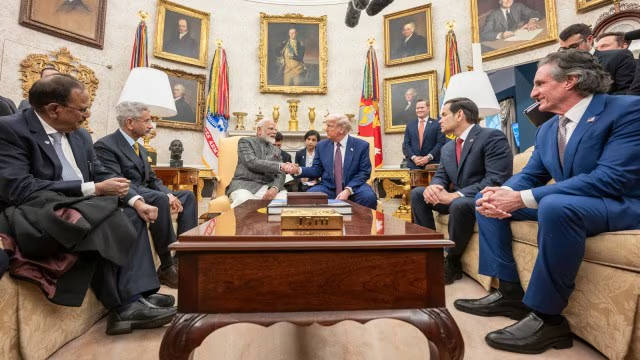As India and the US prepare to work on the contours of a bilateral trade agreement (BTA), New Delhi hopes to secure concessions on the sweeping tariffs announced by US President Donald Trump, such as the 25 per cent tariff on all steel and aluminium, as well as reciprocal tariffs that could impact India’s exports to the US.
“All tariff announcements coming from the US will be addressed in the trade forum, where both countries have agreed to sign a trade deal and increase trade to $500 billion (by 2030). Negotiators from both countries will discuss a roadmap on how to move forward, including (on tariffs) being announced in the US,” a government official said in response to India’s strategy to tackle the 25 per cent tariffs on aluminium and steel.
On reciprocal tariffs, where the US has announced plans to match high tariffs in the partner country, including India, the official said that New Delhi is awaiting clarity on its impact as the US Commerce Secretary is expected to get back with details by April 1.
Moreover, the Senate confirmation of the United States Trade Representative (USTR), America’s top trade body, is also pending, the official added.
However, a White House notification imposing tariffs on steel and aluminium stated that by granting exemptions to certain countries during the initial tariff implementation, the US inadvertently “created loopholes” that were exploited by China and others with excess steel and aluminium capacity, undermining the purpose of these exemptions.
On February 11, the White House said that Argentina, Australia, Brazil, Canada, Japan, Mexico, South Korea, the European Union, Ukraine, and the United Kingdom had received exemptions, which prevented the tariffs from being effective.
However, Reuters reported last week that Trump said he had agreed to consider a tariff exemption on Australian steel and aluminium imports after a telephone call on Tuesday with Australia’s prime minister. Trump noted that the US trade surplus with Australia was one of the reasons he was considering an exemption from the tariffs.
Moody’s Ratings flagged that Indian steel producers will face increased challenges in exporting their products following the US decision to impose an additional 25 per cent tariff on all steel and aluminium imports. Over the past 12 months, high steel imports have already dampened prices and earnings for steel producers in India, said Hui Ting Sim, Assistant Vice President at Moody’s Ratings.
India not the targetIndia not the target
While the US is aiming to reduce its trade deficit, a senior government official said that Washington, DC is looking to rebalance trade with several countries, and India is much lower in the trade deficit hierarchy. “They (US) maintain a very huge deficit with China, Mexico, and Canada,” the official said, adding that both countries are negotiating to boost trade as well.
Even as India lowered its basic Customs duty on a range of items in the Union Budget, a White House statement on reciprocal tariffs last week pointed out that Indian tariffs on agricultural goods and motorcycles remain significantly higher than those imposed by the US on Indian products.
“The US average applied Most Favoured Nation (MFN) tariff on agricultural goods is 5 per cent, while India’s average applied MFN tariff is 39 per cent. India also imposes a 100 per cent tariff on US motorcycles, whereas the US only charges a 2.4 per cent tariff on Indian motorcycles,” the White House said.
Trade diversion could boost India’s exportsTrade diversion could boost India’s exports
Another government official said that while a roadmap is being prepared to sign a deal with the US, not all tariffs imposed may be detrimental to India.
“The Commerce ministry is set to meet with the industry to evaluate the opportunities that could arise from the US tariffs on Canada and Mexico. The trade diversion opportunity could be beneficial to India,” the official said.
Notably, Trump’s tariffs during his first term helped boost India’s electronics exports.
A report from Oxford Economics last year examined the impact of the US-China trade war during Trump’s first term, highlighting that US trade rerouting was particularly pronounced in the large electronics market, where China’s share had dropped by 19 percentage points since 2017.
“India’s share in US electronics imports has risen nearly tenfold since then, reaching 2.1 per cent. Electronics now also account for a greater share of India’s overall exports, indicating that the government’s ongoing efforts to become a high-tech powerhouse have partly paid off,” the report stated.
India’s goods trade surplus with the US has been rising, particularly after the COVID-19 pandemic, doubling from $17.30 billion in 2019-20 to $35.33 billion in 2023-24, alongside a notable shift in the export basket.
While exports of electronic and engineering goods surged, traditional exports such as gems & jewellery and garments remained largely unchanged.
However, Reuters reported last week that Trump said he had agreed to consider a tariff exemption on Australian steel and aluminium imports after a telephone call on Tuesday with Australia’s prime minister. Trump noted that the US trade surplus with Australia was one of the reasons he was considering an exemption from the tariffs.
Moody’s Ratings flagged that Indian steel producers will face increased challenges in exporting their products following the US decision to impose an additional 25 per cent tariff on all steel and aluminium imports. Over the past 12 months, high steel imports have already dampened prices and earnings for steel producers in India, said Hui Ting Sim, Assistant Vice President at Moody’s Ratings.
India not the target
While the US is aiming to reduce its trade deficit, a senior government official said that Washington, DC is looking to rebalance trade with several countries, and India is much lower in the trade deficit hierarchy. “They (US) maintain a very huge deficit with China, Mexico, and Canada,” the official said, adding that both countries are negotiating to boost trade as well.
Even as India lowered its basic Customs duty on a range of items in the Union Budget, a White House statement on reciprocal tariffs last week pointed out that Indian tariffs on agricultural goods and motorcycles remain significantly higher than those imposed by the US on Indian products.
“The US average applied Most Favoured Nation (MFN) tariff on agricultural goods is 5 per cent, while India’s average applied MFN tariff is 39 per cent. India also imposes a 100 per cent tariff on US motorcycles, whereas the US only charges a 2.4 per cent tariff on Indian motorcycles,” the White House said.
Trade diversion could boost India’s exports
Another government official said that while a roadmap is being prepared to sign a deal with the US, not all tariffs imposed may be detrimental to India.
“The Commerce ministry is set to meet with the industry to evaluate the opportunities that could arise from the US tariffs on Canada and Mexico. The trade diversion opportunity could be beneficial to India,” the official said.
Notably, Trump’s tariffs during his first term helped boost India’s electronics exports.
A report from Oxford Economics last year examined the impact of the US-China trade war during Trump’s first term, highlighting that US trade rerouting was particularly pronounced in the large electronics market, where China’s share had dropped by 19 percentage points since 2017.
“India’s share in US electronics imports has risen nearly tenfold since then, reaching 2.1 per cent. Electronics now also account for a greater share of India’s overall exports, indicating that the government’s ongoing efforts to become a high-tech powerhouse have partly paid off,” the report stated.
India’s goods trade surplus with the US has been rising, particularly after the COVID-19 pandemic, doubling from $17.30 billion in 2019-20 to $35.33 billion in 2023-24, alongside a notable shift in the export basket.
While exports of electronic and engineering goods surged, traditional exports such as gems & jewellery and garments remained largely unchanged.



